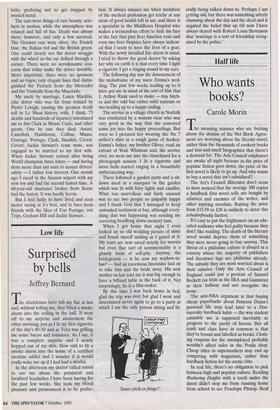High life
Brief lives
Taki
Gstaad
Watching Michael Schumacher win- ning an impressive victory at Nurburgring last Sunday brought back memories. Juan Manuel Fangio pulled off the greatest of his epic drives in the 'Ring' in 1957. Racing a Maserati against Peter Collins and Mike Hawthorne's two Ferraris, Fangio started with half a tank and took a commanding lead. But his pit stop to refuel took longer than expected, giving the other two the lead. With ten laps to go he began chipping away at them, and passed them on the last one, becoming what was called at the time the greatest Formula One driver ever.
If memory serves, Peter Collins was killed in Nurburgring the very next year, in a race won by his best friend and team mate, Mike Hawthorne. Hawthorne was crowned World Champion for 1958, only to die in a road accident on the Guildford bypass that Christmas. I never met Collins or Hawthorne, but was close to Wolfgang von Trips, the German aristocrat who was killed when about to be crowned World Champi- on in the last Grand Prix of 1961 in Monza. All funerals of young men are heartbreak- ing affairs, but his one sticks out in my mind as if it were yesterday.
Von Trips was handsome and had mar- vellous manners. He had come to Greece in 1956 for a hill climb with the Porsche team, which included two other 'lions', Franken- berg and Hanstein. The three German Counts took the first three places with Porsches and that was that. Later, in Paris, von Trips fell madly in love with a Swedish girlfriend of mine, and the three of us made the rounds throughout the winter of 1958. Back then, all we thought of was racing cars. Alas, I had absolutely no talent for it. Taffy von Trips tried to help but to no avail. When I spun out in Magny Cours driving a single seater Formula 3 and felt the petrol dripping on me with no one around to help but a few cows, I decided to stick to tennis, a sport known to be played by poofters and effete playboys.
But my love for Grand Prix racing never wavered. It was the sport's golden age, as well as motor racing's age of innocence. Some drivers wore polo helmets made in Bond Street, while Mike Hawthorne always raced wearing a bow tie. No one wore seat belts, prefering not to get trapped by twisted metal.
The cars were things of rare beauty, arte- facts in motion, while the atmosphere was relaxed and full of fun. Death was always there, however, and only a few survived. The German cars were silver, the French blue, the Italian red and the British green. One could clearly see the driver struggle with the wheel as the car drifted through a corner. There were no aerodynamic con- cerns that today make the driver invisible. More important, there were no sponsors and no logos, only elegant lines that distin- guished the Ferraris from the Mercedes and the Vanwalls from the Maseratis.
My uncle by marriage, Lance Macklin, (the driver who was hit from behind by Pierre Leveg,h, causing the greatest death toll in Le Mans history, with, I think, 73 deaths and hundreds of injuries) introduced me to Jim Clark in Monte Carlo, and other greats. One by one they died. Ascari, Castelloti, Hawthorne, Collins, Musso, Courage, Portago, Clark, Bandini, Cevert. Cevert, Jackie Stewart's team mate, was engaged to be married to my first wife. When Jackie Stewart retired after being World champion three times — and having done more than any man to ensure drivers' safety — I rather lost interest. One month ago I raced in the Saanen airport with my new toy and had the second fastest time. A 60-year-old insurance broker from Berne had the fastest. It was hardly heroic.
But I feel lucky to have lived and seen motor racing at it's best, and to have been friends with the likes of Fon Portago, von Trips, Graham Hill and Jackie Stewart.











































































 Previous page
Previous page